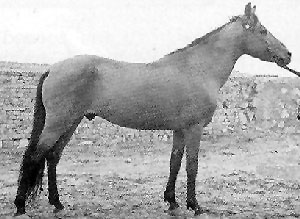
Iomud

Introduction: If you have anything you would like to add to or suggest about this page, please click here!
Names: Iomud. Named after the tribe that originally bred it.
Origin: It
appears that the Iomud breed has the same origins as the Akhal-Teke.
It was developed by the
Iomud tribe in the Tashauz oasis in southern Turkmenia. Originally bred from ancient Turkmenian
horses, poor strains are often improved with Akhal-Teke
blood. During the 14th century, it was influenced by Arabian
stallions. I believe this is a Turkoman tribe, and the "Turkmenian
horses" are probably Turkomans
as well.
There is a rather blatant contradiction in some of the
sources I found for this breed. One says that in contrast to the Akhal-Teke,
the Iomud is kept in the desert and semi-desert. Another states that the Akhal-Teke
is a desert horse, whereas the Iomud comes from the steppes. As most
sources refer to the Akhal-Teke
as a desert horse, I am inclined to believe the latter. This latter source
also says that the pasture on the steppes has produced a slightly smaller and
different type. This wording speaks of a comparison, which I believe is
made between the Akhal-Teke
and the Iomud. One source implies that the breed occupied the
margin of the Turkmenian breed area, and thus it was influenced by steppe
breeds. This tends to support the idea that it was, in essence, a desert
horse, but that there was a mingling of type. I believe this is more
possible than the blatant contrast between the Akhal-Teke
and the Iomud.
Breeding: The purebred population has declined substantially. Stud farms to preserve the Iomud genotype were set up in Turkmenia in 1983. They are charged with protecting the breed and restoring the breeding nucleus to a size of 240-250 mares from the present 140 mares. A conservation farm is being established in the Kyzyl-Atrek district. This must have been inputted before I began to cite the dates of my sources, so I am not sure when "the present" was. I would guess that it was the late 1980's.
Description:
Back: Solid, with small curve to the withers.
Chest: Shallow.
Color: Grey or chestnut; rarely golden chestnut or black.
Croup: Nicely turned and regularly sloping.
Hair: Sparse mane and tail.
Head: Large and clean-cut.
Legs: Clean and fine; often bowed.
Neck: Medium-long.
Profile: Sometimes Roman-nosed.
Size: The measurements below are a little advanced for
me. A translation into simple horse terminology appears to put both
stallions and mares at a little over 14 hands, with the stallions slightly
taller, of course.
The measurements (in centimeters) of stallions
are: height at withers 152, oblique body length 151, chest girth 168, cannon
bone girth 19; mares: 149, 150, 167 and 18.3 respectively.
Skin: Delicate.
Withers: Medium-high.
Temperament:
Features: The Iomud is a long-lived, healthy horse. It shows soft "floating" action.
Uses:
Accomplishments:
Curiosities:
Profiles:
Conclusion: